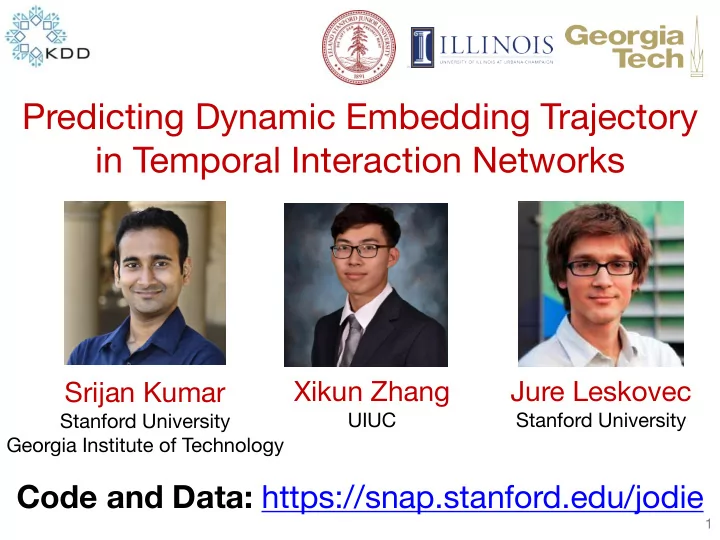

Predicting Dynamic Embedding Trajectory in Temporal Interaction Networks Xikun Zhang Jure Leskovec Srijan Kumar Stanford University Stanford University UIUC Georgia Institute of Technology Code and Data: https://snap.stanford.edu/jodie 1
[KDD’19] Temporal Interaction Networks Flexible way to represent time-evolving relations Represented as a sequence of interactions, Time sorted by time: Feature interaction user item time features Users Items 2
[KDD’19] Temporal Interaction Networks E-commerce Social media …... Education Web Finance IoT Accounts Application domains Posts 3
[KDD’19] Temporal Interaction Networks E-commerce Social media …... Education Web Finance IoT Students Application domains Courses 4
[KDD’19] Problem Setup Given a temporal interaction network interaction user item time features where generate an embedding trajectory of every user and an embedding trajectory of every item 5
[KDD’19] Goal: Generate Dynamic Trajectory 2 4 1 5 6 3 Input: Temporal Output: Dynamic trajectory interaction network in embedding space 6
[KDD’19] Challenges Challenges in modeling: • C1: How to learn inter-dependent user and item embeddings? • C2: How to generate embedding for every point in time? Challenges in scalability: • C3: How to scalably train models on temporal networks? 7
[KDD’19] Existing Methods C1 C2 C3 Co- Embed Train in influence any time batches Deep recommender systems • Time-LSTM (IJCAI 2017) Recurrent Recommender Networks (WSDM • 2017) Latent Cross (WSDM 2018) • Dynamic co-evolution Deep Coevolve (DLRS, 2016) • Temporal network embedding • CTDNE (BigNet, 2018) Our model: JODIE 8
[KDD’19] Our Model: JODIE JODIE: Joint Dynamic Interaction Embedding • Mutually-recursive recurrent neural network framework Update User RNN Item RNN Component Project Projection Component Operator 9
[KDD’19] JODIE: Update Component f = User RNN Item RNN Weight matrices W are trainable • All users share the User-RNN parameters. Similar for items. 10
[KDD’19] JODIE: Project Component f = User RNN Item RNN Projected embedding Time Projection operator Δ Projected embedding How can we predict the next item? • Rank items using distance in the embedding space 11
[KDD’19] Summary: JODIE Formulation Update embeddings: Project user embedding: Predict next item: Loss: Predicted next item is close to the real item Smoothness in evolving embedding embeddings 12
[KDD’19] Challenges in Dynamic Trajectories Challenges in learning: • C1: How to learn inter-dependent user and item embeddings? Solution: Update component • C2: How to generate embedding for every point in time? Solution: Project component Challenges in scalability: • C3: How to scalably train models on temporal networks? 13
[KDD’19] Standard Training Processes: N/A Training must maintain temporal order 5 1 1 User 1 (1) 3 2 2 (2) User 2 3 4 (3) 6 User 3 4 (4) Temporal Batch 1 . . . inconsistency . . . Sequential processing: Split by user (or item): not scalable not allowed 14
[KDD’19] T-batch: Batching for Scalability T-batch: Temporal data batching algorithm • Main idea: create each batch as an independent edge set • Create a sequence of batches – Interactions in each batch are processed in parallel – Process the batches in sequence to maintain temporal ordering 15
[KDD’19] T-batch: Batching for Scalability 2 Iteratively 3 select the 1 maximal 5 independent 6 edge set. 4 3 2 6 1 5 4 Batch 2 Batch 3 Batch 1 16
[KDD’19] Challenges in Dynamic Trajectories Challenges in learning: • C1: How to learn inter-dependent user and item embeddings? Solution: Update component • C2: How to generate embedding for every point in time? Solution: Project component Challenges in scalability: • C3: How to scalably train models on temporal networks? Solution: T-batch Algorithm 17
[KDD’19] Experiments: Prediction Tasks • Temporal Link Prediction: – Which item i ∈ 𝐽 will user u interact with at time t ? • Temporal Node Classification: – Does a user u become anomalous after an interaction? • Settings: – Temporal Splits: 80%, 10%, 10% – Metrics: Mean reciprocal rank, Recall@10, AUROC Code and Data: https://snap.stanford.edu/jodie 18
[KDD’19] Datasets Dataset Users Items Interactions Temporal Anomalies Reddit 10,000 984 672,447 366 NEW! Wikipedia 8,227 1,000 157,474 217 NEW! LastFM 980 1,000 1,293,103 - MOOC 7,047 97 411,749 4,066 Code and Data: https://snap.stanford.edu/jodie 19
[KDD’19] Experiment 1: Link Prediction 1.0 0.73 0.8 0.60 Mean 0.6 0.42 Reciprocal 0.39 0.4 Rank 0.18 0.17 0.2 0.0 Time- RRN Latent CTDNE Deep JODIE LSTM Cross Coevolve JODIE outperforms baselines by > 20% 20
[KDD’19] Experiment 2: Node Classification 1.0 0.9 0.8 0.73 AUROC 0.7 0.65 0.65 0.64 0.63 0.58 0.6 0.5 RRN Latent Deep Time- CTDNE JODIE Cross Coevolve LSTM JODIE outperforms all baselines by >12% 21
[KDD’19] Experiment 3: T-batch Speed-up 50 44 minutes 40 8.5x 30 Running speed-up Time 20 10 5.1 minutes 0 JODIE without JODIE with T-batch T-batch T-batch leads to 8.5x speed-up in training 22
Predicting Dynamic Embedding Trajectory in Temporal Interaction Networks Srijan Kumar, Xikun Zhang, Jure Leskovec JODIE generates and projects embedding trajectories • JODIE: a mutually-recursive RNN framework • T-batch: 8.5x training speed-up • Efficient in temporal link prediction and node classification • Extendible to > 2 entity types Code and Data: https://snap.stanford.edu/jodie 23
Open Positions @ Georgia Tech • Hiring multiple Ph.D. students • Research areas: – Machine Learning for Networks – Safety, Integrity, and Anti-Abuse – Computational Social Science • Collaborations Contact: srijan@cs.stanford.edu 24
Predicting Dynamic Embedding Trajectory in Temporal Interaction Networks Srijan Kumar, Xikun Zhang, Jure Leskovec JODIE generates and projects embedding trajectories • JODIE: a mutually-recursive RNN framework • T-batch: 8.5x training speed-up • Efficient in temporal link prediction and node classification • Extendible to > 2 entity types Code and Data: https://snap.stanford.edu/jodie 25
Recommend
More recommend